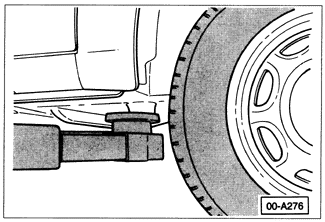Lifting The Car
For those repairs that require raising the car, the proper jacking points should be used to raise the car safely and avoid damage. To use the jack supplied with the car by Volkswagen for changing wheels, there are four jack points-two on each side of the car-marked by dimples in the lower panel sheet metal just behind the front wheel or just in front of the rear wheel. See Fig. 3-1.
To lift the car with a floor jack or hydraulic lift, use the lifting points shown in Fig. 3-2 and Fig. 3-3. At the front, use only the small round member protruding at the bottom of the car under the front door hinge pillar. At the rear, use the flat surface just ahead of the mounting for the rear axle assembly.
| Fig. 3-1. | Jacking point for use with Volkswagen-supplied jack. Dimple in lower panel marks exact point just behind front wheel or just ahead of rear wheel. |

|
NOTE-
On 1990 and later models the jacking point may be behind a hinged flap in the body trim.
|
| Fig. 3-2. | Front lifting point for use with floor jack or hydraulic lift. Lift on round member under front door hinge pillar. |

|
| Fig. 3-3. | Rear lifting point for use with floor jack or hydraulic lift. Lift on flat surface directly in front of rear axle mount. |

|
To raise the car with a jack:
| 1. | Park the car on a flat, level work area. Leave the transmission in neutral, release the brake, and make sure that the car does not roll. |
| 2. | Place the jack in position as shown earlier in Fig. 3-1, Fig. 3-2 or Fig. 3-3. |
| 3. | Make sure that the jack is resting on solid ground, and not tilted or tipping. If necessary use a board or other firm, flat support to provide a solid footing for the jack. |
| 4. | Operate the jack and raise the car slowly. |
WARNING-
Watch the jack closely while raising the car. Make sure that it remains stable and does not shift or tip. The car, or a floor-jack on wheels, will want to roll slightly.
|
| 5. | Once the car is raised to the desired height, block the wheel opposite and farthest from the jack to prevent the car from rolling. For example, when jacking the right front of the car block behind the left rear wheel. |
WARNING-
Do not rely on the transmission or emergency brake to keep the car from rolling. While they will help, neither is a substitute for properly blocking the opposite wheel.
|
WARNING-
Never work under car that is supported only by a jack. Use jack stands that are designed for the purpose of supporting a car. See 4. Tools.
|
To work under the car:
| 1. | Disconnect the battery negative (-) terminal so that no one else can start the car. Let others know what you will be doing. |
| 2. | Use at least two jack stands to support the car. A jack is a temporary lifting device and should never be used alone to support the car while you are under it. Use positively locking jack stands which are designed for the purpose of supporting a car. For more information on jack stands, see 4. Tools. |
WARNING-
Do not use wood, concrete blocks, or bricks to support a car. Wood may split. Blocks or bricks, while they seem strong, are not designed for that kind of load, and may break or collapse.
|
| 3. | Place jack stands on a firm, solid surface, just like the jack. If necessary, use a flat board or similar solid object to provide a firm footing. |
| 4. | After placing the jack stands, slowly release the jack and lower the car until its weight is fully supported by the jack stands. Watch to make sure that the jack stands do not tip as the car settles on them, and that they are placed solidly and will not move. |
| 5. | Observe all jacking precautions again when raising the car to remove the jack stands. |
|


